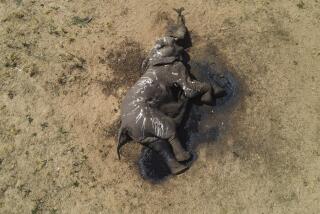An Africa Without Elephants?
- Share via
The black rhino supposedly is protected by official international designation as an endangered species. Still, poachers and smugglers find the black market prices of up to $50,000 for a rhino’s horns to be irresistible. There has been a dramatic increase in poaching. Only about 400 to 450 black rhinos survive in Namibia and officials have launched a strange experiment: the removing of living rhinos’ horns to make the animals worthless to poachers.
A similar and growing problem faces the African elephant. The elephant population has declined at an alarming rate, with the killing of about half the 1.4 million animals counted a decade ago. Kenya, Tanzania and the United States recently announced their support for a worldwide ban on the sale of elephant ivory.
There is hope now that members of the Convention on International Trade in Endangered Species will adopt a prohibition at its October convention in Geneva. Two-thirds of the convention members will have to approve the ban. It would be effective only within those countries that ratify the treaty.
The black rhino experience illustrates that such a ban is not the entire answer to the problem. Some environmentalists believe, in fact, that it would aggravate the situation by driving the trade underground.
To make the ban mean anything, the United States and European nations must use their persuasive and economic powers to help dry up the demand for ivory. At present, Japan and Hong Kong account for 70% of the world’s ivory trade, and may not sign an elephant agreement. Americans and Europeans must try to persuade them of the wisdom of joining the ban. They must work together, as well, in helping the African nations to enforce a prohibition on the further slaying of the elephant. The alternative may be an Africa without wild elephants--a shameful and unthinkable concept.
More to Read
Sign up for Essential California
The most important California stories and recommendations in your inbox every morning.
You may occasionally receive promotional content from the Los Angeles Times.













